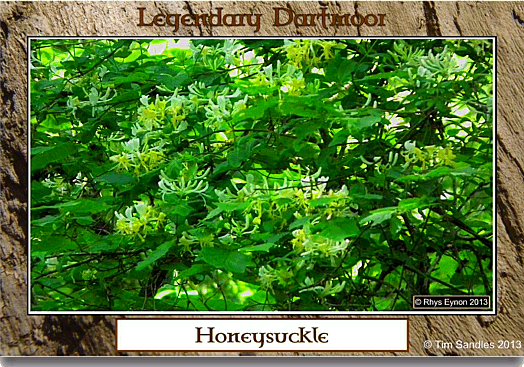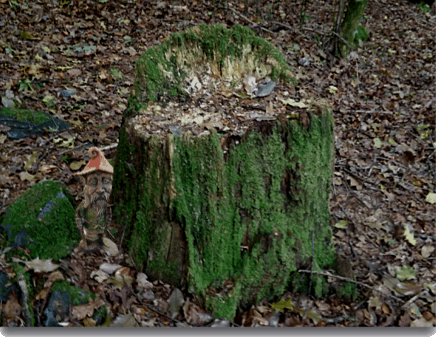
“Sister, sister, what dost thou twine ?
I am weaving a wreath of the wild Woodbine ;
I have streaked it without like the sunset hue,
And silvered it white with the morning dew :
And there is not a perfume which on the breeze blows
From the lips of the Pink or the mouth of the Rose,
That’s sweeter than mine – that’s sweeter than mine :
I have mingled them all in my wild Woodbine“.
Miller
Walk down most Dartmoor lanes on a summer’s evening and the chances are the air will be delicately perfumed by the scent of honeysuckle. In the language of flowers the honeysuckle represents – affection, said by some because it clings to things like a love-struck maid. The honeysuckle can also be known as Woodbine, Withywind and Goat’s Leaf, the latter coming from its ability to climb up craggy and inaccessible places akin to a goat. Many of Dartmoor’s woodland sport a fine display of honeysuckle, a good example is Hisley Wood which I recently visited. As can be seen from the photograph below the plant is flourishing amongst the native trees but also doing an excellent job of invasion.

Many of the old Dartmoor cotts had honeysuckle growing over the door or porch in order to have the sweet scent near the home. In fact to have a healthy growth of honeysuckle around the door was to be protected from any evil which may step across the threshold. In a way the plant along with the rambling rose has become the epitome of the idyllic country cottage.
As a plant it has always been thought unlucky to bring honeysuckle into the house, there has been no explanation on Dartmoor as to why this should be. However, in Cambridgeshire the same idea applies especially if there are young girls living in the house as it is thought to give them erotic thoughts. The piskies were/are meant to favour the honeysuckle nectar at their nocturnal revels which it was/is said take place near a stand of honeysuckle. Amazingly enough on that visit to Hisley Wood we actually found a piskie stool sat near to some honeysuckle which was probably where the sentry sat on revel nights, luckily there was no sign of any piskies?

The curative powers of the honeysuckle are not expansive, on the southern edges of the moor it was said that the blossom of Goat Leaf Honeysuckle could easy asthma attacks. There was also the belief that honeysuckle could act as a treatment for adder bite, anybody being bitten by such a creature should first suck the juice or nectar from the flowers and then rub the bite with its leaves. Quite what this was meant to achieve is anybodies guess but maybe the sweet scent took ones mind of the event? Another use for the honeysuckle was that of a laxative made from the flowers. Skin complains and rashes can be cured by applying poultices made from honeysuckle leaves.
On a more practical note, in some areas honeysuckle would be planted at the foot of young apple trees in order to occupy the middle of the tree. This in effect stifled any growth from the heart and encouraged the tree to branch out to the edges thus making it more fruitful. It was however very important to remove the honeysuckle after a few years in order that it couldn’t completely colonise the tree. Occasionally you may see a walking stick known as a ‘twisty stick’ which was a hazel rod that had spiral grooves caused by the honeysuckle growing up it.
When you consider both the above attributes of honeysuckle the plant doesn’t seem so sweet and innocent. It is said that if the plant is left to its own devices it can literally choke the life out of whatever it decides to grow up.
 Legendary Dartmoor The many aspects past and present of Dartmoor
Legendary Dartmoor The many aspects past and present of Dartmoor
